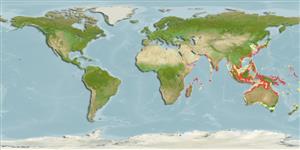Common names from other countries
Environment: milieu / climate zone / depth range / distribution range
Ecologia
; intervalo de profundidade 0 - 50 m. Tropical
Indo-West Pacific: from East Africa, including the Red Sea and the Persian Gulf to Papua New Guinea; north to Japan and south to Queensland.
Length at first maturity / Tamanho / Peso / Idade
Maturity: Lm ? range ? - ? cm Max length : 8.5 cm TL macho/indeterminado; (Ref. 348); common length : 7.5 cm TL macho/indeterminado; (Ref. 348)
Half-buried in fine to medium sand bottoms, with abundant fragmental shell material and subject to the effects of currents and wave action. Littoral and sublittoral (Ref. 348).
Life cycle and mating behavior
Maturidade | Reprodução | Desova | Ovos | Fecundidade | Larvas
Members of the class Bivalvia are mostly gonochoric, some are protandric hermaphrodites. Life cycle: Embryos develop into free-swimming trocophore larvae, succeeded by the bivalve veliger, resembling a miniature clam.
Poutiers, J.M. 1998. (Ref. 348)
Categoria na Lista Vermelha da IUCN (Ref. 130435)
Categoria CITES (Ref. 108899)
Not Evaluated
Not Evaluated
Ameaça para o homem
Harmless
Utilização humana
Pescarias: espécies comerciais
| FishSource |
Ferramentas
Mais informação
Idade/Tamanho
Crescimento
Comprimento-peso
Comprimento-comprimento
Morfologia
Larvas
Abundância
Fontes da internet
Estimates based on models
Preferred temperature
(Ref.
115969): 23.8 - 29.1, mean 28.1 (based on 1288 cells).
Vulnerabilidade
Low vulnerability (10 of 100).
Categoria de preço
Unknown.
